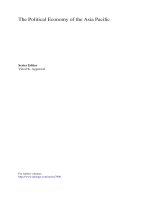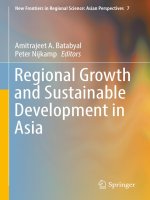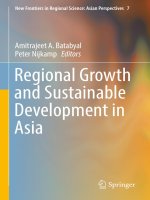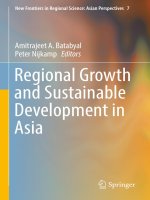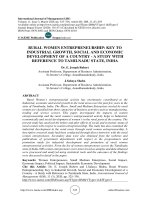Economic growth and economic development 181
Bạn đang xem bản rút gọn của tài liệu. Xem và tải ngay bản đầy đủ của tài liệu tại đây (44.5 KB, 1 trang )
Introduction to Modern Economic Growth
States, there should exist some arrangement such that these new technologies can
be imported and everybody could be made better off.
Another challenge to models of multiple steady states concerns the ubiquity of
growth miracles such as South Korea and Singapore, which we discussed in Chapter
1. If cross-country income differences are due to multiple steady states, from which
escape is impossible, then how can we explain countries that embark upon a very
rapid growth process? The example of China may be even more telling here. While
China stagnated under communism until Mao’s death, the changes in economic
institutions and policies that took place thereafter have led to very rapid economic
growth. If China was in a low-growth steady state before Mao’s death, then we need
to explain how it escaped from the steady state after 1978, and why it did not do
so before? Inevitably this takes us to the role of other fundamental causes, such as
institutions, policies and culture.
A different, and perhaps more promising, argument on the importance of luck
can be made by emphasizing the role of leaders. Perhaps it was Mao who held back
China, and his death and the identity, beliefs and policies of his successor were at the
root of its subsequent growth. Perhaps the identity of the leader of a country can
thus be viewed as a stochastic event, shaping economic performance. This point
of view probably has a lot of merit. Recent empirical work by Jones and Olken
(2005) shows that leaders seem to matter for the economic performance of nations.
Thus luck could play a major role in cross-country income and growth differences
by determining whether growth-enhancing or growth-retarding leaders are selected.
Nevertheless, such an explanation is closer to the institutional approaches than the
pure luck category. First of all, leaders will often influence the economic performance
of their societies by the policies they set and the institutions they develop. Thus,
the selection and behavior of leaders and the policies that they pursue should be a
part of the institutional explanations. Second, Jones and Olken’s research points to
an important interaction between the effect of leaders and a society’s institutions.
Leaders seem to matter for economic growth only in countries where institutions
are non-democratic or weak (in the sense of not placing constraints on politicians
or elites). In democracies and in societies where other institutions appear to place
167



